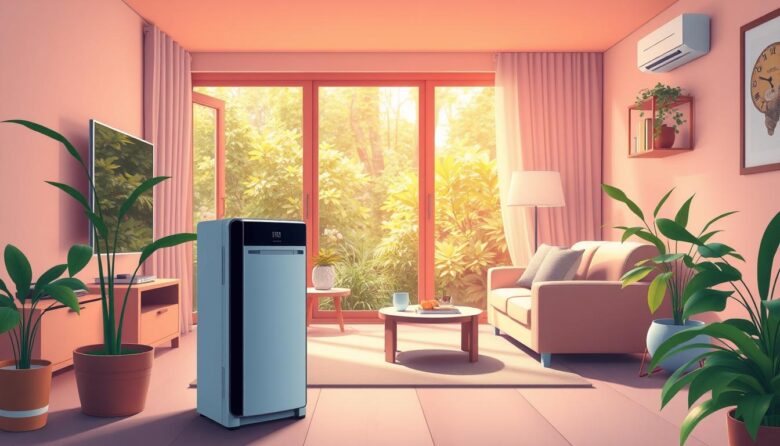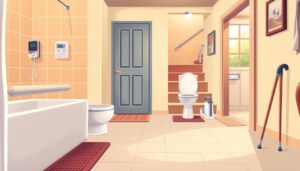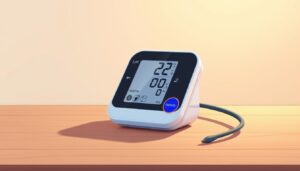Did you know the air inside your home could be up to five times dirtier than outdoor air? The Environmental Protection Agency warns that common pollutants like dust, mold, and chemicals often linger where we feel safest. For older adults, these invisible threats can quietly affect lung capacity, heart function, and even blood circulation.
As we age, our bodies become less efficient at filtering irritants. Weaker immune systems and natural respiratory changes make seniors more sensitive to poor indoor environments. While removing pollution sources works best, it’s not always practical—especially in homes where renovations or major lifestyle changes aren’t feasible.
This guide focuses on practical ways to create healthier living spaces. You’ll learn how modern filtration systems address specific challenges faced by older individuals. We’ll break down the science connecting fresh environments to better physical wellness, helping you choose solutions that fit unique needs.
Key Takeaways
- Indoor spaces often contain 2-5x more pollutants than outdoor areas (EPA data)
- Age-related changes increase vulnerability to airborne irritants
- Respiratory and cardiovascular health directly link to environment quality
- Source removal remains the first defense against contamination
- Targeted filtration systems offer backup protection when elimination fails
Understanding Indoor Air Quality and Its Impact on Senior Health
Indoor spaces can silently impact seniors’ well-being through pollutants you might not see or smell. The EPA confirms household environments often contain 2-5 times more contaminants than outdoor areas. Let’s explore what’s floating in your living spaces and why it matters for aging loved ones.
Air Pollutants in Indoor Environments
Common irritants like dust mites and mold spores thrive in carpets, bedding, and damp areas. Volatile organic compounds (VOCs) from cleaners, paints, or furniture finishes add chemical risks. Even cooking fumes release particles smaller than 0.3 microns—tiny enough to bypass natural defenses in aging lungs.
Pet dander and pollen stick to fabrics, circulating whenever you move furniture or open windows. Poor ventilation traps these pollutants, creating a cycle of exposure. Consumer Reports testing shows many homes exceed safe thresholds for multiple contaminants.
Health Considerations for Older Adults
Natural aging reduces lung elasticity and weakens cough reflexes, making it harder to expel irritants. Immune systems also become less effective at fighting inflammation caused by prolonged exposure. This combination can worsen asthma, trigger allergies, or strain cardiovascular systems over time.
Watch for symptoms like persistent coughing, shortness of breath, or unexplained fatigue. These signs often point to environmental factors affecting overall physical health. Managing indoor conditions becomes crucial when mobility limitations keep older adults inside for extended periods.
How Air Purifiers Enhance Indoor Air Quality
Your home’s unseen dangers require smart solutions. Top-rated models in Consumer Reports’ testing removed 98% of dust and smoke particles within hours. These systems tackle pollutants through layered defense strategies, combining physical capture and chemical neutralization.
Mechanisms of Filtration Technology
True HEPA filters form the backbone of effective systems. They trap particles as small as 0.3 microns – including pollen and bacteria – with hospital-grade efficiency. A pre-filter first catches larger debris like lint, protecting the main filter from premature clogging.
Activated carbon layers then tackle gaseous threats. These porous materials absorb cooking odors, formaldehyde from furniture, and other volatile compounds. Some units add UV-C light to disable microorganisms, while ionizers help clump tiny particles for easier capture.
Reducing Common Indoor Contaminants
Multi-stage systems address specific household challenges. Pet dander gets trapped in mechanical filters before reaching sensitive lungs. Smoke particles meet carbon’s absorption power, reducing respiratory irritation risks.
Advanced models automatically adjust fan speeds when sensors detect rising pollutant levels. This smart operation maintains cleaner spaces without constant manual adjustments. Regular maintenance ensures filters work at peak performance throughout their lifespan.
Benefits of Air Purifiers for Seniors
Imagine resting through the night without coughing fits or stuffy noses. Modern systems create environments where older adults breathe easier and sleep deeper. These solutions tackle invisible threats that particularly affect those with existing health conditions.
Improved Breathing and Sleep Quality
Cleaner spaces reduce nighttime irritants that disrupt rest. By capturing microscopic particles, advanced filtration helps maintain open airways. This leads to fewer wake-ups from congestion or labored breathing.
Studies show consistent use correlates with longer REM cycles. Those with chronic respiratory issues often report needing less medication. Better sleep supports immune function and daytime energy levels.
Minimizing Allergens and Pet Dander
Companion animals bring joy but also shed skin flakes that trigger reactions. HEPA-grade technology captures these particles without removing furry friends from homes. It traps 99.97% of allergens as small as 0.3 microns.
Reduced exposure means fewer antihistamines and nasal sprays. Families notice decreased sneezing fits and itchy eyes. This balance preserves both physical comfort and emotional bonds.
Key Features to Look for in an Air Purifier
What separates effective filtration systems from basic dust collectors? The answer lies in smart engineering that balances performance with practicality. Let’s explore what makes certain models stand out for maintaining healthier spaces.
Filter Quality and Lifespan
Genuine HEPA filters capture 99.97% of particles down to 0.3 microns—critical for trapping allergens and bacteria. Watch for misleading “HEPA-type” labels that offer lower efficiency. Pair this with activated carbon layers that neutralize odors from cooking or household chemicals.
Washable pre-filters extend primary filter life by catching larger debris first. Quality HEPA units typically last 6-12 months, while carbon layers need more frequent replacement. Look for indicator lights that signal when maintenance is due.
Energy Efficiency and Noise Control
Modern systems use less power than a standard light bulb. Energy Star-certified models cut costs without sacrificing performance. Quiet operation below 50 dB ensures peaceful sleep—about as loud as a refrigerator hum.
Smart sensors automatically adjust fan speeds when detecting pollutants. This feature maintains clean environments while conserving energy. Always check decibel ratings for nighttime modes if sensitivity to sound exists.
Understanding Room Size and Air Flow Requirements
The right cleaner for your space starts with simple math. Every model has limits, and choosing one too small leaves gaps in protection. Measure your space carefully—length times width gives square footage, but don’t stop there.
Calculating Appropriate Square Footage Coverage
Manufacturers list maximum room sizes, but real-world performance depends on airflow. Look for units rated 20% larger than your space to handle furniture and doorways. For a 300-square-foot living area, pick a 360-square-foot capacity model.
Air changes per hour (ACH) matter most. Experts recommend 4-6 complete refreshes for optimal quality. A 200-square-foot bedroom needs a device moving at least 800 cubic feet of air hourly (200 sq ft × 8 ft ceiling × 5 ACH). Adjust calculations if ceilings exceed 9 feet.
Portable units under 20 pounds with wheels simplify moving between spaces. Always position them centrally, 3 feet from walls and curtains. This prevents airflow blockages and lets the system pull in contaminants efficiently.
Large rooms like open-concept living areas demand powerful models. Compact units work for bedrooms but struggle in shared spaces. Match your device’s capabilities to where time is spent—especially areas used for reading, meals, or family visits.
Choosing the Right Air Purifiers for Seniors: A Comprehensive Buyer’s Guide
Finding the perfect system requires more than just comparing price tags. With over 180 models tested by Consumer Reports, the gap between top performers and underachievers is staggering. Top-rated units removed 98% of dust and pollen at both high and low speeds, while others failed basic particle capture tests entirely.
Evaluating Specifications and User Reviews
Look beyond marketing claims to independently verified data. Reputable labs test how devices handle real-world challenges like fluctuating humidity or furniture-blocked airflow. Prioritize models maintaining 90%+ efficiency on low settings—critical for uninterrupted nighttime use without disruptive noise.
Scrutinize customer feedback patterns. Reliable systems consistently earn praise for three-year+ durability and intuitive controls. Watch for recurring complaints about filter replacement hassles or confusing interfaces. Families caring for older adults often highlight ease of maintenance as a deciding factor.
Balance lab results with practical needs. A unit excelling in controlled environments might struggle with pet hair in carpeted homes. Check manufacturer support options—companies specializing in senior-friendly designs often offer extended warranties and dedicated troubleshooting lines.
Evaluating Performance Ratings and CADR Values
How can you tell if a device truly cleans your space? The answer lies in two numbers: CADR and air changes per hour. These metrics reveal whether a system lives up to its promises or just moves air around.
Interpreting CADR and Air Changes Per Hour
Clean Air Delivery Rate (CADR) measures how fast a unit removes dust, pollen, and smoke. Higher numbers mean faster cleaning. A model claiming 1,560 sq ft coverage with 207 CADR? It actually cleans under 400 sq ft effectively at recommended settings.
Calculate your needs by multiplying room volume (length × width × height) by 4-6 air changes. For 10x12x8 ft spaces: 960 cubic feet × 5 changes = 4,800 CFM. Match this to a device’s CADR rating.
Fan speed impacts both performance and noise. Some units lose 40% efficiency on lower settings. Look for models maintaining 90%+ particle removal in quiet modes. Test data shows top performers work well at medium speeds.
Real-world benefits matter most. During pollen season, high CADR means faster relief. At night, consistent low-speed operation keeps irritants down without sleep disruption. Check third-party lab reports—not just marketing claims—for true capabilities.
Understanding Filter Types: HEPA, Activated Carbon, and More
Not all filters work the same way – some capture dust while others neutralize odors. Knowing these differences helps you maintain cleaner spaces without wasting money on unnecessary upgrades. Let’s break down what really matters when choosing and caring for these components.
True HEPA vs. Standard HEPA Explained
True HEPA filters meet strict 99.97% efficiency standards for trapping particles as small as 0.3 microns. Beware of “HEPA-type” labels – these often capture less than 90% of irritants. Premium models like PuroAir use medical-grade H14 filters (99.995% efficiency), but most homes don’t need this extra 0.025% boost.
Standard HEPA filters work well for everyday needs. Unless someone has severe immunodeficiency, the tiny efficiency gap won’t affect health outcomes. Focus instead on proper sizing and regular maintenance.
Filter Maintenance and Replacement Tips
Activated carbon layers need swapping every 3-6 months since they fill up with absorbed chemicals. HEPA filters typically last 6-12 months, but pet owners might replace them quarterly. Always check your manufacturer’s guidelines – some systems track usage automatically.
Save money by vacuuming pre-filters weekly. Set phone reminders for replacements, and buy multipacks when discounts hit. Proper care keeps systems running at peak performance without overspending.
Smart Features in Air Purifiers for Modern Seniors
Modern technology brings convenience to maintaining cleaner living spaces. Intelligent systems now handle complex tasks automatically, letting you focus on daily activities without constant monitoring. These innovations prove especially helpful for those preferring simplicity in their routines.
WiFi Connectivity and Remote Control Options
Smartphone apps transform how you manage air quality. Connected models send real-time updates about particle levels and chemical contaminants. Adjust fan speeds from your couch or check status during trips – no need to touch the device.
Create custom schedules that match daily patterns. Program units to activate before morning routines or switch to quiet nighttime modes automatically. Filter replacement alerts arrive directly on your phone, eliminating guesswork.
Air-Quality Sensors and Auto Adjustments
Built-in detectors work like environmental guardians. They track invisible threats and boost cleaning power when needed. A sudden cooking smell triggers faster airflow, then reduces speed once air clears.
This hands-free operation ensures consistent protection even if you forget manual setting changes. Models with light indicators provide visual feedback, showing when spaces meet safety thresholds.
Design Considerations and Noise Level Implications
Creating a peaceful home environment starts with smart design choices. Modern systems blend powerful cleaning with features that respect your daily rhythm. Let’s explore how thoughtful engineering balances performance with comfort.
Silent Guardians During Rest Hours
Night-friendly models operate quieter than a whisper—some dip below 31 decibels. The Coway Mighty demonstrates this, producing less sound than rustling leaves on its lowest setting. Adjust fan speeds remotely when entering or leaving spaces to maintain tranquility.
Place units on stable surfaces away from beds to minimize vibrations. Schedule high-speed cycles for midday cleaning bursts when rooms sit empty. This strategy tackles pollutants without disrupting relaxation time.
Movement and Visual Harmony
Lightweight machines under 20 pounds glide easily on hidden wheels. Built-in handles and compact shapes simplify relocating units between living areas and bedrooms. Neutral colors and minimalist profiles help devices blend into your decor rather than dominate it.
Look for displays that dim automatically at night. Touch controls with raised icons aid those with vision changes. These details transform functional tools into seamless parts of your home’s ecosystem.



